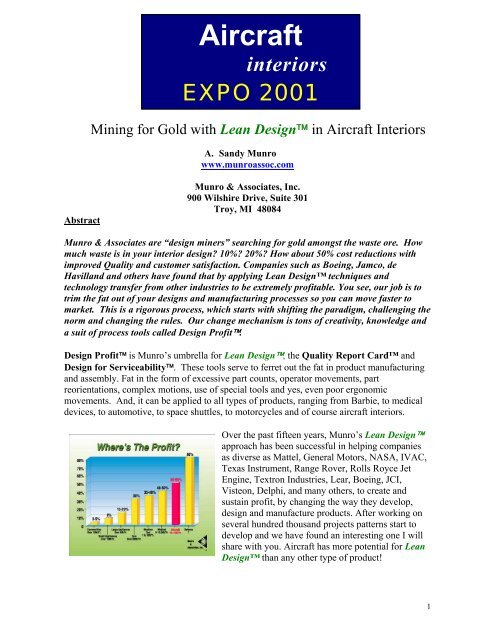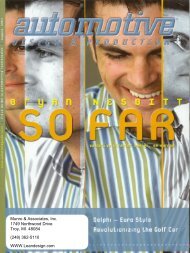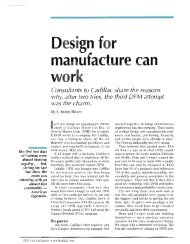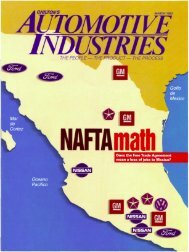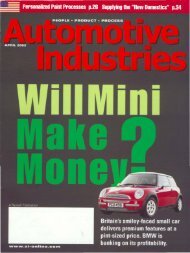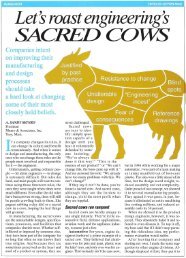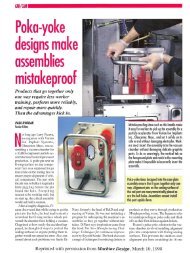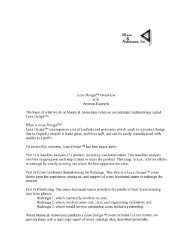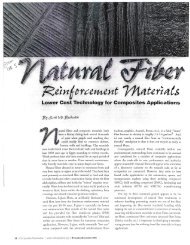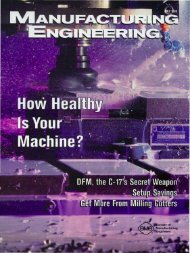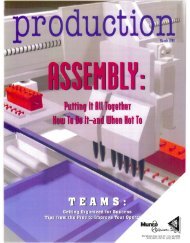Sandy Munro - Mining for Gold with Lean Design in Aircraft Interiors
Sandy Munro - Mining for Gold with Lean Design in Aircraft Interiors
Sandy Munro - Mining for Gold with Lean Design in Aircraft Interiors
Create successful ePaper yourself
Turn your PDF publications into a flip-book with our unique Google optimized e-Paper software.
<strong>Aircraft</strong><br />
<strong>in</strong>teriors<br />
EXPO 2001<br />
<strong>M<strong>in</strong><strong>in</strong>g</strong> <strong>for</strong> <strong>Gold</strong> <strong>with</strong> <strong>Lean</strong> <strong>Design</strong> <strong>in</strong> <strong>Aircraft</strong> <strong>Interiors</strong><br />
A. <strong>Sandy</strong> <strong>Munro</strong><br />
www.munroassoc.com<br />
Abstract<br />
<strong>Munro</strong> & Associates, Inc.<br />
900 Wilshire Drive, Suite 301<br />
Troy, MI 48084<br />
<strong>Munro</strong> & Associates are “design m<strong>in</strong>ers” search<strong>in</strong>g <strong>for</strong> gold amongst the waste ore. How<br />
much waste is <strong>in</strong> your <strong>in</strong>terior design 10% 20% How about 50% cost reductions <strong>with</strong><br />
improved Quality and customer satisfaction. Companies such as Boe<strong>in</strong>g, Jamco, de<br />
Havilland and others have found that by apply<strong>in</strong>g <strong>Lean</strong> <strong>Design</strong> techniques and<br />
technology transfer from other <strong>in</strong>dustries to be extremely profitable. You see, our job is to<br />
trim the fat out of your designs and manufactur<strong>in</strong>g processes so you can move faster to<br />
market. This is a rigorous process, which starts <strong>with</strong> shift<strong>in</strong>g the paradigm, challeng<strong>in</strong>g the<br />
norm and chang<strong>in</strong>g the rules. Our change mechanism is tons of creativity, knowledge and<br />
a suit of process tools called <strong>Design</strong> Profit.<br />
<strong>Design</strong> Profit is <strong>Munro</strong>’s umbrella <strong>for</strong> <strong>Lean</strong> <strong>Design</strong>, the Quality Report Card and<br />
<strong>Design</strong> <strong>for</strong> Serviceability. These tools serve to ferret out the fat <strong>in</strong> product manufactur<strong>in</strong>g<br />
and assembly. Fat <strong>in</strong> the <strong>for</strong>m of excessive part counts, operator movements, part<br />
reorientations, complex motions, use of special tools and yes, even poor ergonomic<br />
movements. And, it can be applied to all types of products, rang<strong>in</strong>g from Barbie, to medical<br />
devices, to automotive, to space shuttles, to motorcycles and of course aircraft <strong>in</strong>teriors.<br />
Over the past fifteen years, <strong>Munro</strong>’s <strong>Lean</strong> <strong>Design</strong><br />
approach has been successful <strong>in</strong> help<strong>in</strong>g companies<br />
as diverse as Mattel, General Motors, NASA, IVAC,<br />
Texas Instrument, Range Rover, Rolls Royce Jet<br />
Eng<strong>in</strong>e, Textron Industries, Lear, Boe<strong>in</strong>g, JCI,<br />
Visteon, Delphi, and many others, to create and<br />
susta<strong>in</strong> profit, by chang<strong>in</strong>g the way they develop,<br />
design and manufacture products. After work<strong>in</strong>g on<br />
several hundred thousand projects patterns start to<br />
develop and we have found an <strong>in</strong>terest<strong>in</strong>g one I will<br />
share <strong>with</strong> you. <strong>Aircraft</strong> has more potential <strong>for</strong> <strong>Lean</strong><br />
<strong>Design</strong> than any other type of product!<br />
1
At <strong>Munro</strong> & Associates, we don’t make products, but we do make them more profitable.<br />
Consider these Team<strong>Munro</strong> success stories. Here are a few:<br />
- Consolidated parts <strong>in</strong> a console assembly, reduced the number of parts by 33%, the build<br />
time by 40%, and the piece cost by 12%.<br />
- Reduced the overall cost of a Lavatory by 50% plus added extra features.<br />
- On an exhaust system improved the customer satisfaction <strong>in</strong>dex by 30X and reduced the<br />
total cost by 80%<br />
- Redesigned an accelerator pedal and reduced the number of parts from seven and one,<br />
generated an estimated 70% cost sav<strong>in</strong>gs and elim<strong>in</strong>ated 100% of the assembly labor.<br />
If you have the burn<strong>in</strong>g need to <strong>in</strong>crease Quality and profitability, you need Team<strong>Munro</strong>.<br />
The <strong>Lean</strong> <strong>Design</strong> Process – The Four T’s<br />
Tim<strong>in</strong>g: Do It Right The First Time:<br />
The key to big success is tim<strong>in</strong>g. While <strong>in</strong> the concept stage, OEM’s are experiment<strong>in</strong>g <strong>with</strong><br />
designs; designs, which can create a life sentence of satisfaction or great frustration on the<br />
factory floor. <strong>Design</strong> is the most critical step and the driv<strong>in</strong>g <strong>for</strong>ce <strong>in</strong> the manufactur<strong>in</strong>g<br />
process. The proof is <strong>in</strong> the analyses of the product’s total manufactur<strong>in</strong>g cost, illustrated <strong>in</strong><br />
Diagram (1). Product design may only account <strong>for</strong> five percent of a product’s total cost, but<br />
it dictates 75 percent of the product’s total manufactur<strong>in</strong>g cost. There<strong>for</strong>e, it becomes critical<br />
that designs are done right, the first time. While <strong>in</strong> the concept stage, designs can be modified<br />
easily <strong>with</strong> a stroke of a pen and few mouse clicks. Changes are rapid and relatively<br />
<strong>in</strong>expensive. If additional changes are needed after the design is complete, one must consider<br />
all of the downstream activities, which may be affected, such as per<strong>for</strong>mance test<strong>in</strong>g,<br />
assembly and check<strong>in</strong>g fixtures, secondary tools and production tool<strong>in</strong>g. As seen <strong>in</strong> Diagram<br />
(2) as the product time l<strong>in</strong>e progresses the cost to implement changes rises exponentially. To<br />
summarize, though it is never too late to do what is right, the later the change, the more<br />
expensive the correction.<br />
Influence On Total Manufactur<strong>in</strong>g Cost<br />
Cost of Product Changes<br />
2
Team<strong>Munro</strong>’s lesson is to slow down <strong>in</strong> the concept stage so you can move faster on the<br />
factory floor, because the factory floor is where value is created. Slow<strong>in</strong>g down means<br />
tak<strong>in</strong>g the time to elim<strong>in</strong>ate the fat from product design to create a lean design. Analysis such<br />
as <strong>Lean</strong> <strong>Design</strong> usually require 20 percent more up-front eng<strong>in</strong>eer<strong>in</strong>g cost and time, but it<br />
typically yields a 50 percent sav<strong>in</strong>g <strong>in</strong> cost and time down-stream.<br />
Teamwork:<br />
Why teamwork It is not one person, but the collective ef<strong>for</strong>t of many specialized people who<br />
implement the process of product design and manufactur<strong>in</strong>g. Just look at a few of the<br />
necessary product development steps: styl<strong>in</strong>g, design, test<strong>in</strong>g, tool<strong>in</strong>g, manufactur<strong>in</strong>g and<br />
assembly. If we look at the cycle as a l<strong>in</strong>ear set of steps, where one person completes a task<br />
and throws it over the wall to the next person or department, who <strong>in</strong> turn completes their task<br />
and throws it over the wall until the last task is complete, what are the chances that the<br />
outcome will meet the first person or department <strong>in</strong>tentions Probably slim. The reason is<br />
lack of communication and shar<strong>in</strong>g of <strong>in</strong><strong>for</strong>mation. But, if everyone is <strong>in</strong> the same room at<br />
the same time, <strong>in</strong><strong>for</strong>mation can be exchanged. Every team member has an opportunity to<br />
voice concerns and resolve these concerns <strong>for</strong> the collective benefit of the team and the<br />
product. It is a w<strong>in</strong>-w<strong>in</strong> <strong>for</strong> people and products. The right team has several success<br />
<strong>in</strong>gredients: commitment, early <strong>for</strong>mation, and multi-discipl<strong>in</strong>ary.<br />
Commitment vs. Contribution:<br />
There is a big difference between contribution and commitment. Contribution is short -term<br />
assistance; commitment on the other hand, is sometimes legal, but always a morally b<strong>in</strong>d<strong>in</strong>g<br />
dedication. Though both are voluntary, one is a def<strong>in</strong>ite b<strong>in</strong>d<strong>in</strong>g arrangement, that once<br />
<strong>in</strong>itiated is hard to break <strong>with</strong>out consequences. When <strong>in</strong> a commitment, it becomes personal,<br />
and each member is mutually accountable <strong>for</strong> the outcome, no f<strong>in</strong>ger po<strong>in</strong>t<strong>in</strong>g, shift<strong>in</strong>g blame<br />
or excuses. So, it is understandable that many people are very leery about commitments.<br />
But, no great <strong>in</strong>vention, discovery, <strong>in</strong>novation or breakthrough came about through<br />
contribution. There is no substitute <strong>for</strong> commitment, you either are or you are not.<br />
Team<strong>Munro</strong> has a say<strong>in</strong>g; “A focused, committed team will outper<strong>for</strong>m a group of<br />
<strong>in</strong>dividuals <strong>with</strong> more technology but less focus every time”. So, if success is the desired<br />
outcome, commitment is the first, and most important <strong>in</strong>gredient.<br />
Early:<br />
Early team <strong>for</strong>mation is essential. Gett<strong>in</strong>g <strong>in</strong> early guarantees every team member has the<br />
capability to <strong>in</strong>fluence the design <strong>in</strong> the concept stage. And as we said earlier, product design<br />
dictates 75 percent of the product’s total manufactur<strong>in</strong>g cost. So, gett<strong>in</strong>g to the gate on time<br />
is important if you want to w<strong>in</strong> the race.<br />
Multi-discipl<strong>in</strong>ary:<br />
To w<strong>in</strong> the race everyone needs to hand the baton over to the next person or department so<br />
they can run their leg of the race. If that person or department is not represented or present,<br />
everyone on the team loses the race. This is why all product discipl<strong>in</strong>es must be represented,<br />
3
from the f<strong>in</strong>ance office to the factory floor; <strong>in</strong>clude men and women, union and management,<br />
OEM and suppliers. Have you ever noticed a team on the play<strong>in</strong>g field You cannot tell one<br />
member from another, if it was not <strong>for</strong> the number on the back of their jersey The reason is<br />
simple, everyone on the team is an equal and important member, and collectively, they<br />
present a united front. That is a Team. Every member works towards a common goal. They<br />
have a function to per<strong>for</strong>m, and have an equal stake <strong>in</strong> the outcome.<br />
Tra<strong>in</strong><strong>in</strong>g:<br />
Teams tra<strong>in</strong> to w<strong>in</strong>. Tra<strong>in</strong><strong>in</strong>g is the process used to strengthen and stretch team members to<br />
go beyond their current skill set and limitations. Futurist, Joel Barker speaks to the<br />
“paradigm effect” <strong>in</strong> which <strong>in</strong>dividuals and teams see only what they want to see because<br />
they are bl<strong>in</strong>ded by their own experiences and perspectives. In product design, the “paradigm<br />
effect” creates bl<strong>in</strong>d spots where there is opportunity. The end result is parts and products<br />
that never change. The <strong>Lean</strong> <strong>Design</strong> tra<strong>in</strong><strong>in</strong>g helps people to break-through the paradigms<br />
so the team can beg<strong>in</strong> to th<strong>in</strong>k <strong>in</strong> new and creative ways. The process of product design<br />
break-through beg<strong>in</strong>s <strong>with</strong> chang<strong>in</strong>g the rules.<br />
Tools:<br />
<strong>Lean</strong> <strong>Design</strong> is Team<strong>Munro</strong>’s change kit. The process beg<strong>in</strong>s <strong>with</strong> BOB. BOB is<br />
Team<strong>Munro</strong>s’ Bl<strong>in</strong>dfolded – One arm – Builder. He is a member of every <strong>Lean</strong> <strong>Design</strong><br />
team. And, when you design <strong>for</strong> BOB as a teammate, everyth<strong>in</strong>g beg<strong>in</strong>s to change. BOB is<br />
the change agent, because he changes the rules. Now, every team must beg<strong>in</strong> to th<strong>in</strong>k<br />
differently to accommodate BOB <strong>in</strong> their product designs. The Good <strong>Design</strong> Pr<strong>in</strong>ciples and<br />
the Part Value Challenge are focused on ensur<strong>in</strong>g BOB can do his job.<br />
Good <strong>Design</strong> Pr<strong>in</strong>ciples:<br />
• Teamwork – The Difference Between Good/ Bad <strong>Design</strong>s<br />
• M<strong>in</strong>imize The Number Of Parts<br />
• Avoid Excessive Secondary Operations<br />
• <strong>Design</strong> Out Handl<strong>in</strong>g Problems – Th<strong>in</strong>k Bulk Storage<br />
• Use Gravity, Don’t Fight It<br />
• <strong>Design</strong> Parts That Are Easy To Insert/Align – <strong>Design</strong> <strong>for</strong> BOB<br />
• <strong>Design</strong> The Parts To Fixture Themselves One To Another<br />
• <strong>Design</strong> The Product For Poka-Yoke – <strong>Design</strong> <strong>for</strong> BOB<br />
• Question Servic<strong>in</strong>g And Simplify Or Elim<strong>in</strong>ate Packag<strong>in</strong>g<br />
• Elim<strong>in</strong>ate Movements, Adjustments, Ergonomic Problems, And Reorientations<br />
The Part Value Challenge: Good Part or Bad Part r<br />
1. Does It Have To Move<br />
2. Does It Have To Be A Fundamentally Different Material<br />
Is there a part you can’t decide on When In Doubt, Throw It Out!<br />
4
Poor Quality Drivers: Elim<strong>in</strong>ate them! Achieve better quality!<br />
1. Fasteners<br />
2. Spr<strong>in</strong>gs<br />
3. Belts<br />
The easiest way to illustrate the impact of these simple rules is to review a product example.<br />
Product Example:<br />
Below is an exploded view of and exist<strong>in</strong>g stamped and riveted metal armrest bracket<br />
assembly and the <strong>Lean</strong> <strong>Design</strong> Assembly Diagram. The Assembly Diagram graphically<br />
illustrates the follow<strong>in</strong>g:<br />
• There are 11 parts designated by ■<br />
• There are 9 Fasten<strong>in</strong>g Operations designated by <br />
• There are 7 Tools designated by <br />
• There are 5 Operations designated by •<br />
• And 2 Subassemblies (Side Arms) designated by <br />
Side Arm Assembly<br />
Top<br />
Side Arm<br />
Rivets<br />
Cl<strong>in</strong>ch Nut<br />
Pivot<br />
Only one part<br />
passes the test!<br />
OH 2<br />
OH 2<br />
WG 1<br />
HM 5<br />
8<br />
OH 2<br />
OH 2<br />
First<br />
VR 2<br />
VR 2<br />
Fixture<br />
OH 2<br />
MA 2<br />
MA 2<br />
0<br />
2<br />
6<br />
5 3<br />
0<br />
6 3<br />
5<br />
5<br />
Cl<strong>in</strong>ch<br />
Side<br />
Stake<br />
Remove<br />
New<br />
Pivot<br />
Replace<br />
Stake<br />
OH 2<br />
Nut<br />
Arm<br />
Fixture<br />
P<strong>in</strong><br />
Sidearm<br />
VR 2<br />
OH 2<br />
OH 2 MA 2<br />
OH 2<br />
MA 2<br />
VR 2<br />
VR 2 HD 2<br />
X2 X2<br />
VR 2<br />
HD 2<br />
X2<br />
<br />
16<br />
4 4 4 3 0<br />
16<br />
4<br />
4<br />
4<br />
X2<br />
Top<br />
Side<br />
Stamp<strong>in</strong>g<br />
Arm<br />
Right<br />
OH 2<br />
VR 2<br />
MA 2<br />
Rivet<br />
Gun<br />
Rivet<br />
Upset<br />
Rivet<br />
Flip<br />
Refixture<br />
OH 2<br />
VR 2<br />
MA 2 OH 2<br />
Side<br />
Arm<br />
Left<br />
Rivet<br />
Gun<br />
Rivet<br />
Upset<br />
Rivet<br />
5 3<br />
6<br />
0<br />
3 5 6<br />
2<br />
0<br />
Stake<br />
Replace<br />
Sidearm<br />
Pivot<br />
P<strong>in</strong><br />
New<br />
Remove<br />
Fixture<br />
Stake<br />
Side<br />
Arm<br />
Cl<strong>in</strong>ch<br />
Nut<br />
First<br />
Fixture<br />
Us<strong>in</strong>g the Part Value Challenge and Poor Quality Drivers, we look to elim<strong>in</strong>ate the fat from<br />
the design <strong>in</strong> the <strong>for</strong>m of unnecessary parts and operations. We start by assign<strong>in</strong>g value to<br />
5
one part, the part that most represents the work be<strong>in</strong>g done by the entire system, i.e. the top.<br />
All other assembled parts to the top are challenged <strong>for</strong> part value. Analyz<strong>in</strong>g each<br />
component, the follow<strong>in</strong>g are elim<strong>in</strong>ated:<br />
The Part Value Challenge: Good Part or Bad Part r<br />
1. Does It Have To Move<br />
2. Does It Have To Be A Fundamentally Different Material – (Side Arms r, Pivot r)<br />
3. When In Doubt, Throw It Out<br />
Poor Quality Drivers:<br />
• No Spr<strong>in</strong>gs<br />
• No Belts<br />
• No Fasteners – (Rivets r, Cl<strong>in</strong>ch Nuts r)<br />
The analysis shows only one part is necessary to satisfy BOB; it is the top.<br />
But this is not the best design!<br />
We found a way to decrease weight<br />
and <strong>in</strong>corporate the cloth and foam<br />
<strong>in</strong> one step! All <strong>for</strong> less money than<br />
the metal bracket alone!<br />
Redesigned One-Piece Armrest Bracket<br />
The creative process of bra<strong>in</strong>storm<strong>in</strong>g is used to generate redesign ideas to meet the new <strong>Lean</strong><br />
<strong>Design</strong> requirements. In this example, the break through is material selection. Unless the<br />
team is will<strong>in</strong>g to embrace new material choices and manufactur<strong>in</strong>g processes, the answer will<br />
never surface and the product improvement will be <strong>in</strong>significant. A one-piece plastic armrest<br />
bracket is a very feasible idea <strong>in</strong>volv<strong>in</strong>g only eng<strong>in</strong>eer<strong>in</strong>g, no development or research.<br />
Team<strong>Munro</strong> calls this Low Innovation.<br />
Low Innovation: These ideas require eng<strong>in</strong>eer<strong>in</strong>g only. The technology is not new to the<br />
product market and all team members feel com<strong>for</strong>table that, <strong>with</strong> m<strong>in</strong>imum test<strong>in</strong>g and<br />
validation the ideas can be <strong>in</strong>corporated.<br />
Medium Innovation: The medium risk idea requires development. It may be a technology<br />
utilized by another <strong>in</strong>dustry or a comb<strong>in</strong>ation of materials and processes unfamiliar to the<br />
team. This level can sometimes product patentable ideas and is the most likely level to<br />
implement.<br />
Stretch: These ideas are <strong>in</strong>ventions and require research, experimentation, test<strong>in</strong>g and<br />
validation. They are ideas that are on the edge of a new paradigm and <strong>in</strong> some cases thrust<br />
their companies to the <strong>for</strong>efront of their bus<strong>in</strong>esses. Almost always patentable, these ideas are<br />
the ones, which have the potential to leapfrog past the competition.<br />
6
But how can we make it “Faster, Cheaper and Better”<br />
• Br<strong>in</strong>g all relevant <strong>in</strong><strong>for</strong>mation about the product or ideas: Sketches, draw<strong>in</strong>gs, parts,<br />
prototypes, FMEA’s and appeals, competitors products, $APPEALS, competitors<br />
products, QFD specifications, costs, weights, data, labor rates and product volumes.<br />
In other words, the more data the better.<br />
• Assign component numbers to the parts as they are logged <strong>in</strong> order of assembly on the<br />
<strong>Lean</strong> <strong>Design</strong> worksheet and carry out the part value challenge. (Good Part or<br />
Bad Part r)<br />
• If work<strong>in</strong>g on a concept design, calculate the design efficiency immediately. If the<br />
value is less than 30%, stop, redesign and reanalyze.<br />
• Create the assembly sequence chart. Document all assembly processes <strong>in</strong>clud<strong>in</strong>g the<br />
use of jigs, tools, and all non-value-added operations such as reorientations and<br />
multiple handl<strong>in</strong>g.<br />
• Keep good notes and make sketches throughout the process.<br />
• Fill <strong>in</strong> the appropriate penalty units and identify poka-yoke, ergonomic and service<br />
opportunities <strong>for</strong> design.<br />
• On service items, calculate the service <strong>in</strong>dex. If more than one area <strong>for</strong> service exists,<br />
then total the <strong>in</strong>dices to determ<strong>in</strong>e the overall service <strong>in</strong>dex.<br />
Flow Chart of Method:<br />
7
Project Steps <strong>for</strong> Exist<strong>in</strong>g Product <strong>Design</strong>:<br />
• Familiarization: Project Leader Reviews The <strong>Design</strong> Status<br />
• Assembly Diagram Of The Current <strong>Design</strong> – Establish Basel<strong>in</strong>e<br />
• Analysis of current design:<br />
Good Parts -VS - Bad Parts r<br />
Get Parts – Look at the problems BOB will encounter when he tries to remove<br />
a part from its shipp<strong>in</strong>g conta<strong>in</strong>er and gets it ready to “PUT” <strong>in</strong>to place<br />
Put Parts – Once BOB has the part <strong>in</strong> his hand he must put the part <strong>in</strong>to the<br />
assembly. BOB’s problems <strong>with</strong> gett<strong>in</strong>g the part are usually small compared<br />
to putt<strong>in</strong>g it <strong>in</strong>to position.<br />
Poka-Yoke – To Do Without Thought.<br />
Material Costs<br />
• Bra<strong>in</strong>storm:<br />
Generate Ideas – Go <strong>for</strong> Quantity not Quality<br />
Rank Ideas By Quality and Risk Level<br />
Package Into Concepts<br />
• Redesign<br />
• Analyze Redesign Concepts (Same as Analysis Of Current <strong>Design</strong>)<br />
• Prepare Presentations<br />
Summary:<br />
At <strong>Munro</strong> & Associates, we have three rules <strong>for</strong> bus<strong>in</strong>ess: <strong>in</strong>novate, <strong>in</strong>novate, <strong>in</strong>novate.<br />
Product eng<strong>in</strong>eers should dare to deviate, to move away from the norm. “We always did it<br />
that way be<strong>for</strong>e,” is a sure sign that progress is stagnant. And, while you’re stand<strong>in</strong>g still, the<br />
competition is pass<strong>in</strong>g you by. Joel Barker says of <strong>in</strong>dustry, “If the rules change, everyth<strong>in</strong>g<br />
goes back to zero”. In other words, if the competition develops a new design or process,<br />
which essentially obsoletes your product, you are sent back to ground zero. Most companies<br />
avoid dramatic changes until they are at risk, and when it is too late. But, if you can start the<br />
change process be<strong>for</strong>e there are signs of trouble, there is a huge competitive advantage.<br />
Promot<strong>in</strong>g cont<strong>in</strong>uous product improvement through the use of powerful tools, such as <strong>Lean</strong><br />
<strong>Design</strong>, is one sure remedy <strong>for</strong> stagnate, lack luster product designs. The ga<strong>in</strong>s achieved<br />
through cont<strong>in</strong>uous product development activities will keep you <strong>in</strong> the market share race.<br />
Innovation, on the other hand, will escalate you to a leadership position. Innovation beg<strong>in</strong>s<br />
<strong>with</strong> chang<strong>in</strong>g the rules and shift<strong>in</strong>g the paradigms. – So, ask yourself this simple question:<br />
“What today is impossible to do, but if it could be done…. Would fundamentally put your<br />
competition back to zero”<br />
$64,01 and 2.1 oz<br />
$3.59 and 0.8 oz<br />
8


